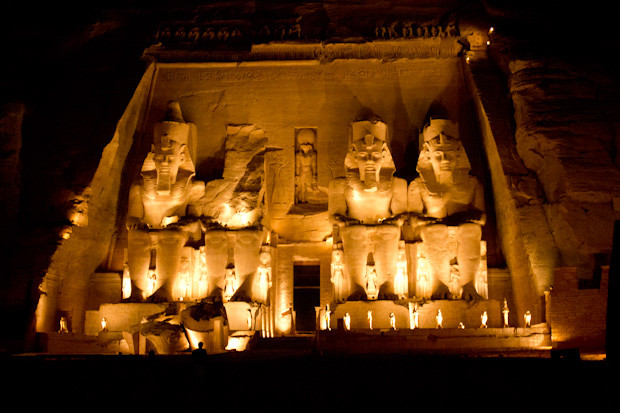The Friday Photo: Abu Simbel by Night
The four colossi below depict Ramses II, a talented and courageous soldier, devoted husband and full-blown egomaniac who was Egypt’s longest-reigning pharaoh. 70 feet tall and carved out of a sandstone cliff, they dominate even Ramses’ fellow gods with their presence, let alone his miniature children.
Way, way down in the deep south of Egypt, only a few miles from the Sudanese border, Ramses’ temple at Abu Simbel was buried under sand for thousands of years until Giovanni Belzoni, the circus strongman turned Egyptologist, first located it almost two centuries ago.
When Egypt dammed the Nile to create Lake Nasser, the world’s largest artificial lake, the temple would have been submerged. But in an engineering feat that still wows even now, a UNESCO team sliced both the temple and the mountain into thousands of blocks, and relocated it a few hundred metres inland, on higher ground.
Illuminated under a starry Nubian sky, it is every bit as imposing as the pyramids — and noticeably more handsome than Ramses’ unwrapped mummy would suggest.


I must say I felt this was much more mind-blowing than the pyramids, perhaps because I had seen the pyramids in textbooks for so long I was a bit prepared for it. When I went here in 1998, I hadn’t even heard of it. Even the story of the engineering feat of preserving it is incredible. Not to be missed! I envy your night photo as we could only fly in for a couple hours due to closing of the highway after the 1997 terror attacks at Hatshepsut Temple.
Rameses II’s reputation as a grand victor against the Hittites as depicted on the walls inside, however, is quite the piece of propaganda. He had fallen into a trap and did a rather impressive job getting out of it all and driving the Hittites back, but ultimately he failed to capture Kadesh. What he should be more famous for is the eventual peace treaty he made with them. Allegedly the first recorded peace treaty between empires in the history of humankind!
We saw the insides today, Kevin, and the Kadesh stuff is an amazing piece of propaganda and personal image-making. I put “talented and courageous” in the post because what he (personally) seems to have done at Kadesh, i.e. leap in his chariot, charge forward and rally the army at considerable personal risk, thereby saving them from utter defeat, was a piece of individual bravery along the lines of Richard Coeur de Lion.
I almost wanted to go into the detail on that, and then I thought it would be overkill, so it’s sod’s law that my first comment is about… Kadesh. Gah! 😉 I almost wanted to go into detail on the “loving husband” stuff as well, and then I thought, nah! it’s a picture post…
Z observed that he feels rather sorry for the Hittite princess who accompanied the peace treaty, as, now he’s pointed it out, so do I. It can’t have been much fun stuck in the harem palace with, I think, no children of her own…
GORGEOUS photos, Theodora! I’d honestly rather see this than the pyramids any day. I don’t know much about ancient Egyptian history, but from Kevin’s comment (and yours) it sounds like Ramses II was quite the character.
I clearly need to do some geeky Ancient Egyptian history stuff! There are a few very strong characters who stand out over the 3000-year era, and Ramses II is one (also Hatshepsht, the female king, Nefertiti and Akhenaten). We hit Tutankhamun territory quite soon. Very exciting…